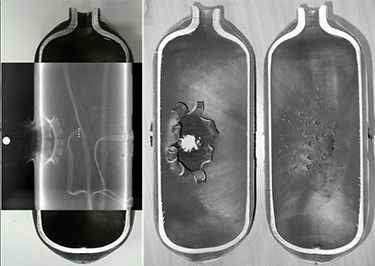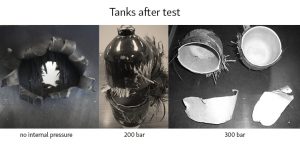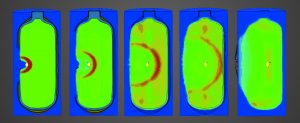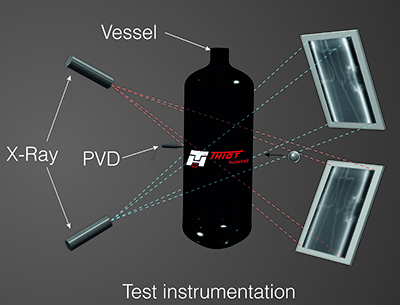The threat of an impact on a satellite has become serious enough for it to be studied, in particular in relation to its vital components. In the framework of a vast programme directed by the French space agency, CNES, THIOT INGENIERIE conducted a study to assess the vulnerability of satellite tanks in the event of an impact from space debris. The end goal is to contribute to developing a method to address this problem in the case of a new pressurised tank to be used in space.
The impact of a projectile of several millimetres in diameter perforating a vessel can cause it to explode or result in a catastrophic fuel leak. One of the questions that the manager of a space mission must address is what is an acceptable level of tank pressure, considering a strike by space debris of a given mass and speed.
By extrapolation, numerical simulation enables us to assess vessel behaviour in the context of real impact speeds, based on laboratory experiments. The method used by THIOT INGENIERIE is thus based on a synergy between experimentation and calculation, resulting in damage assessment according to the mass and speed of the debris and the pressure of the vessel.
Goals of the study
To conduct this study, the experts at THIOT INGENIERIE carried out tests on tanks made from an aluminium structure, pre-stressed by a wound carbon/epoxy composite.
To assess the role of the pressurised gas contained in the vessel in the event of an impact, three tests were carried out and simulated, namely on:
- 1 tank without internal pressure (atmospheric pressure)
- 1 tank with a pressure of 200 bar
- 1 tank with a pressure of 300 bar
The primary goal of these tests was to determine the limits at which the vessels would explode, according to the internal pressure, and to collect as much data as possible on the phenomena that come into play during impact (penetration and fragmentation of the projectile, propagation of shock waves, manner of explosion, etc.).
Experimental tests
 The tests were conducted at our shock physics laboratory using one of our two-stage gas guns to reach very high speeds. State-of-the-art instruments (X-rays, interferometer, HV, strain gauges) were used during the strikes to observe physical phenomena and gather enough data to feed the simulations.
The tests were conducted at our shock physics laboratory using one of our two-stage gas guns to reach very high speeds. State-of-the-art instruments (X-rays, interferometer, HV, strain gauges) were used during the strikes to observe physical phenomena and gather enough data to feed the simulations.
Movement measurements and strain measurements provide data at several points of the structure during impact. In parallel, the X-ray measurements allow images to be taken during impact, in particular, fragmentation of the projectile inside the vessel and propagation of shock waves in the pressurised gas.
For each of the tests, the projectile was an aluminium ball of 8 mm diameter, projected at a speed of 4400 m/s.
- Tank at 1 bar of internal pressure: it can be noted that the composite has been distorted around the impact hole and the opposite inner side in aluminium has many impacts from debris, which reflect the fragment cloud generated by the impact. The X-ray image shows the petal shape of the aluminium liner at the point of impact and the fragment cloud that developed inside the tank. We can also make out the peculiar shape of the sprayback of matter, directed towards the outside of the tank.
- Tank at 200 bar of internal pressure: a large fragment of the tank came off and the carbon fibres surrounding it are very damaged. No impact from debris can be seen on the opposite inner side. The wave seen by X-ray in front of the debris cloud formation is interpreted as the shock wave transmitted in the pressurised gas. The speed of the debris cloud decreases after the impact.
- Tank at 300 bar of internal pressure: the tank is severed into two parts and the composite is very damaged. The opposite inner side in aluminium does not show any impact. The speed of the debris cloud decreases more than in the previous test. The lips, produced by the impact hole, are in the opposite direction to the firing axis.
These tests show that the speed of the debris cloud generated by the impact decreases when the tank contains pressurised gas. When gas is present, a shock wave develops in front of the debris cloud following the impact. The fragment cloud is slowed down by the aerodynamic forces of pressurised gases and does not reach the opposite side of the vessel.
 Complexity and contribution of numerical calculations
Complexity and contribution of numerical calculations
Numerical simulations allowed us to exploit the results obtained during the tests to improve understanding of the phenomena observed and extrapolate the results to real-life situations. For example, in the case of this study where the speed of space debris can reach 20 km/s – a speed impossible to reproduce experimentally in a laboratory. The complementarity between experimental tests and simulations lies in the fact that measurements taken at a few special points can be correlated to then obtain the behaviour at any point by simulation.
Simulating the behaviour of the vessel is complex in this case. This study combines several problems that strongly interfere with each other:
- Complex materials: multiple layers of aluminium and composite materials
- Pre-stressing exerted by the composite layers
- Modelling of these materials bursting when subjected to hypervelocity impacts
- Simulation of fragmentation
- Consideration of the gas pressure inside the tank
- Simulation of the shock wave in the gas
- Interactions between projectile/tank, projectile/gas and tank/gas
 To achieve this goal, the simulations combine three formulations available in LS-DYNA: Lagrangian, SPH and ALE with coupling between each of them, which was never done before for this type of simulation.
To achieve this goal, the simulations combine three formulations available in LS-DYNA: Lagrangian, SPH and ALE with coupling between each of them, which was never done before for this type of simulation.
Static initialisation is necessary to take into account initial pre-stressing in the materials before carrying out the dynamic simulation.
The interactions between the various formulations and solvers brought into play in this study meant that beta versions of the computer code had to be used because these new possibilities of multiphysics interactions are still only at the development stage.
The correlation work between experiment/calculation led to a better understanding of the sequencing of various phenomena during impact. One important finding of the study is that the bursting of the tank’s aluminium structure at 300 bar is due to the loss of pre-stressing exerted by the carbon fibre layers, resulting in the tank opening due to the pressure.

